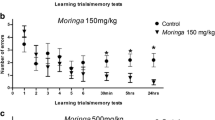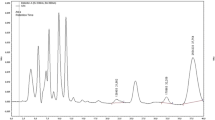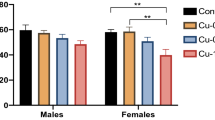Abstract
Food (cassava) linamarin is metabolized into neurotoxicants cyanide and cyanate, metabolites of which we sought to elucidate the differential toxicity effects on memory. Young 6–8 weeks old male rats were treated intraperitoneally with either 2.5 mg/kg body weight (bw) cyanide (NaCN), or 50 mg/kg bw cyanate (NaOCN), or 1 μl/g bw saline, daily for 6 weeks. Short-term and long-term memories were assessed using a radial arm maze (RAM) testing paradigm. Toxic exposures had an influence on short-term working memory with fewer correct arm entries (F 2, 19 = 4.57 p < 0.05), higher working memory errors (WME) (F 2, 19 = 5.09, p < 0.05) and longer RAM navigation time (F 2, 19 = 3.91, p < 0.05) for NaOCN relative to NaCN and saline treatments. The long-term working memory was significantly impaired by cyanide with fewer correct arm entries (F 2, 19 = 7.45, p < 0.01) and increased working memory errors (F 2, 19 = 9.35 p < 0.05) in NaCN relative to NaOCN or vehicle treated animals. Reference memory was not affected by either cyanide or cyanate. Our study findings provide an experimental evidence for the biological plausibility that cassava cyanogens may induce cognition deficits. Differential patterns of memory deficits may reflect the differences in toxicity mechanisms of NaOCN relative to NaCN. Cognition deficits associated with cassava cyanogenesis may reflect a dual toxicity effect of cyanide and cyanate.



Similar content being viewed by others
References
Amizet L, Pruvot G, Remy S, Kfoury M (2011) Occupational cyanide poisoning. BMJ Case Rep. doi:10.1136/bcr.09.2011.4865
Banea-Mayambu JP, Tylleskar T, Gitebo N, Matadi N, Gebre-Medhin M, Rosling H (1997) Geographical and seasonal association between linamarin and cyanide exposure from cassava and the upper motor neurone disease konzo in former Zaire. Trop Med Int Health 2:1143–1151
Banea-Mayambu JP, Tylleskar T, Tylleskar K, Gebre-Medhin M, Rosling H (2000) Dietary cyanide from insufficiently processed cassava and growth retardation in children in the Democratic Republic of Congo (formerly Zaire). Ann Trop Paediatr: Int Child Health 20:34–40
Blanche PA, Yuet WK, David GN (1974) Toxic effects of high-dose cyanate administration in Rodents. Blood 43:69–77
Boivin MJ, Okitundu D, Makila-Mabe Bumoko G, Sombo MT, Mumba D, Tylleskar T, Page CF, Tamfum Muyembe JJ, Tshala-Katumbay D (2013) Neuropsychological effects of konzo: a neuromotor disease associated with poorly processed cassava. Paediatr 131:e1231–e1239
Carlsson L, Mlingi N, Ronquist G, Rosling H (1995) A specific and sensitive method for determination of linamarin in urine. Nat toxins 3:378–382
Chin RG, Calderon Y (2000) Acute cyanide poisoning: a case report. J Emerg Med 18:441–445
Cliff J, Nacala D (1997) Long term follow-up of konzo patients. Trans Royal Soc Trop Med 91:447–449
Cliff J, Muquingue H, Nhassico D, Nzwalo H, Bradbury JH (2011) Konzo and continuing cyanide intoxication from cassava in Mozambique. Food Chem Toxicol 49:631–635
Crist RD, Grisolia S, Bettis CJ, Grisolia J (1973) Carbamoylation of proteins following administration to rats of carbamoyl phosphate and cyanate and effects of memory. Eur J Biochem 32:109–116
Dudchenko PA (2004) An overview of the tasks used to test working memory in rodents. Neurosci and Behav Rev 28:699–709
Essers AJA, Alsen P, Rosling H (1992) Insufficient processing of cassava induced intoxications and the paralytic disease konzo in a rural area of Mozambique. Ecol Food and Nutr 27:17–27
Fando J, Grisolia S (1974) Carbamylation of brain proteins with cyanate in vitro and in vivo. Eur J Biochem 47:389–396
Frey U, Mathies H, Reymann KG (1991) The effect of dopaminergic D1 receptor blockade during tetanization on the expression of long term potentiation in the rat CA1 region in vitro. Neurosci Lett 129:111–116
Hayes WT (1967) The 90-dose LD50 and a chronicity factor as measures of toxicity. Toxicol and Appl Pharmacol 11:327–335
Hodges H (1996) Maze procedures: the radial-arm and water maze compared. Cogn Brain Res 3:167–181
Kassa RM, Kasensa NL, Monterroso VH, Kayton RJ, Klimek JE, David LL, Lunganza KR, Kayembe KT, Bentivoglio M, Juliano SL, Tshala-Katumbay DD (2011) On the biomarkers and mechanisms of konzo, a distinct upper motor neuron disease associated with food (cassava) cyanogenic exposure. Food Chem Toxicol 49:571–578
Kuramoto T, Nakanishi S, Ochiai M, Nakagama H, Voigt B, Serikawa T (2012) Origins of albino and hooded rats: implications from molecular genetic analysis across modern laboratory rat strains. PLoS ONE 7:e43059
Mathangi DC, Namasivayam A (2000a) Effect of cassava consumption on open-field behavior and brain neurotransmitters in albino rats. Physiol & Behav 70:89–93
Mathangi DC, Namasivayam A (2000b) Effect of chronic cyanide intoxication on memory in Albino Rats. Food and Chem Toxicol 38:51–55
Mills EM, Gunasekar PG, Pavlakovic G, Isom GE (1996) Cyanide-induced apoptosis and oxidative stress in differentiated PC 12 cells. J Neurochem 67:1039–1046
Nunn PB, Lyddiard JR, Christopher Perera KP (2011) Brain glutathione as a target for aetiological factors in neurolathyrism and konzo. Food Chem Toxicol 49:662–667
Nzwalo H, Cliff J (2011) Konzo: from poverty, cassava, and cyanogen intake to toxico-nutritional neurological disease. PLoS Negl Trop Dis 5:e1051
Okafar PN, Okorowkwo CO, Maduagwu EN (2002) Occupational and dietary exposures of humans to cyanide poisoning from large-scale cassava processing and ingestion of cassava foods. Food and Chem Toxicol 40:1001–1005
Olton DS (1985) The radial arm maze as a tool in behavioral pharmacology. Physiol & Behav 40:793–797
Olton DS, Samuelson RJ (1976) Remembrance of placed passed: spatial memory in rats. J Exp Psychol: Anim Behav Proc 2:97–116
Rosling H (1994) Measuring effects in humans of dietary cyanide exposure from cassava. Acta Hortic 375:271–283
Rosling H, Tylleskar T (1995) Konzo an epidemic upper motor neuron disease associated to cassava and agro-ecological collapse in Africa. In: Tropical Neurology. Sauders, London, pp 353–364
Rosling H, Gessain A, de Thé G, Ebondo N, Banea M, Bikangi N, Kinjanja K, Nunga M (1988) Tropical and epidemic spastic paraparesis are different. Lancet 8596:1222–1223
Speiser Z, Amitz-Zonder J, Ashkenazi R, Gitter S, Cohen S (1990) Central catecholaminergic dysfunction and behavioural disorders following hypoxia in adult rats. Behav and Brain Res 37:19–27
Spencer PS (1999) Food toxins, AMPA receptors, and motor neuron diseases. Drug Metab Rev 31:561–587
Swenne I, Eriksson UJ, Christoffersson R, Kagedal B, Lundquist P, Nilsson L, Tylleskar T, Rosling H (1996) Cyanide detoxification in rats exposed to acetonitrile and fed a low protein diet. Fundam Appl Toxicol 32:66–71
Sykes AH (1981) Early studies on the toxicology of cyanide. In: Vennesland B, Conn EE, Knowles CJ, Westley J, Wissing F (eds) Cyanide in biology. Academic Press, London, pp 1–9
Tewe OO, Maner JH (1982) Cyanide protein and iodine interaction in the physiology and metabolism of rats. Food Chem 9:195–204
Tor-Agbidye J, Palmer VS, Lasarev MR, Craig AM, Blythe LL, Sabri MI, Spencer PS (1999) Bioactivation of cyanide to cyanate in sulfur amino acid deficiency: relevance to neurological disease in humans subsisting on cassava. Toxicol Sci 50:228–235
Tshala-Katumbay D, Lukusa VM, Eeg-Olofsson K (2000) EEG findings in Konzo: a spastic para/tetraparesis of acute onset. Clin Electroencephalogr 31:196–200
Tshala-Katumbay D, Eeg-Olofsson K, Tylleskar T, Kazadi-Kayembe T (2001) Impairments, disabilities and handicap pattern in konzo - a non-progressive spastic para/tetraparesis of acute onset. Disabil and Rehabil 23:731–736
Tylleskär T, Banea M, Bikangi N, Fresco L, Persson LÅ, Rosling H (1991) Epidemiological evidence from Zaire for a dietary aetiology of konzo, an upper motor neuron disease. Bull World Health Organ 69:581–590
Way JL (1984) Cyanide intoxication and its mechanism of antagonism. Ann Rev Pharmacol Toxicol 24:451–481
Wenk G, Sweeney J, Hughey D, Carson J, Olton D (1986) Choline acetyltransferase inhibition does not impair radial maze performance in rats. Pharmacol, Biochem Behav 25:521–526
Acknowledgments
Partially supported by the International Society for Neurochemistry/Committee for Aid and Education in Neurochemistry and the NIEHS and FIC grant R21ES017225 and R01ES019841 from the National Institutes of Health, Bethesda, MD.
Author information
Authors and Affiliations
Corresponding author
Rights and permissions
About this article
Cite this article
Kimani, S., Sinei, K., Bukachi, F. et al. Memory deficits associated with sublethal cyanide poisoning relative to cyanate toxicity in rodents. Metab Brain Dis 29, 105–112 (2014). https://doi.org/10.1007/s11011-013-9459-2
Received:
Accepted:
Published:
Issue Date:
DOI: https://doi.org/10.1007/s11011-013-9459-2




